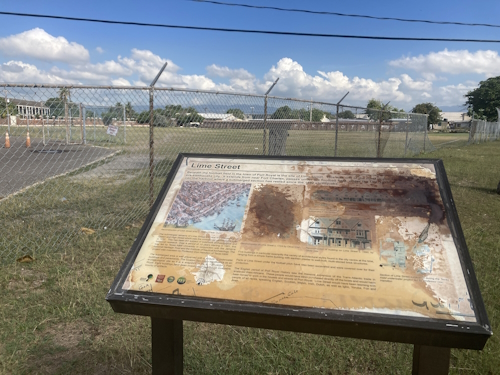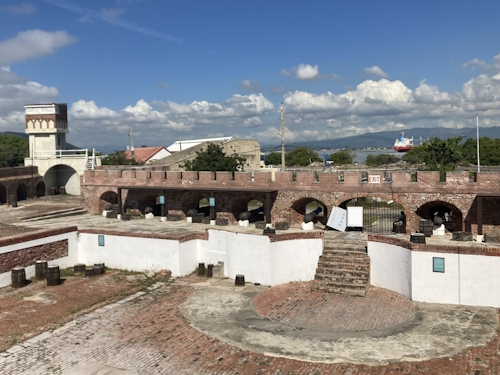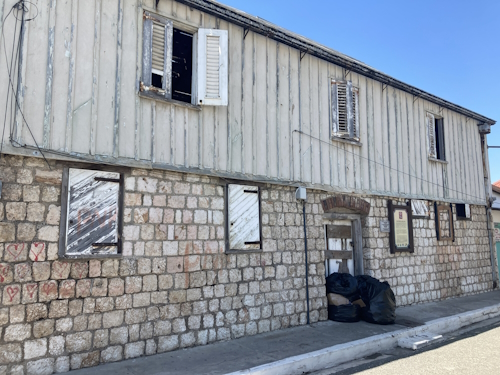Blog TWHS Visits
The Underwater City of Port Royal
We saw confirmation in December 2023 that Jamaica planned to submit The Underwater City of Port Royal as its 2025 nomination; whether they did so in time I could not verify. It will be their fourth attempt to get this site inscribed. It was rejected in 1988 (only the terrestrial area, deemed of national importance only), deferred in 2019 (more focus on the 17th century needed and worries about a cruise ship pier) and had an incomplete dossier last year. In 2019 ICOMOS did find some potential OUV though (“a possibly unrivalled illustration of an English colonial town in the 17th century”) and Jamaica may now have taken the right path of approach that will lead to an inscription. It will consist of a terrestrial and a marine part (comprising an underwater archaeological site). My review will only cover the terrestrial part, which I visited earlier this week.
Port Royal, a small fishing town at the end of a tombolo known as Palisadoes, is easily reached by bus from Downtown Kingston. The ride on bus 98 takes 45 minutes and costs 70 JD (0,40 EUR). This bus also stops at the airport, so you could theoretically combine a trip to Port Royal with your departure or arrival. Be aware though that it is a very hot area and you won’t want to carry any luggage. It’s a relaxed place to roam around for a bit, a random guy yelling out to me in the street “Hey! Do you wanna buy a crab?” exemplifies the laid-back atmosphere.
The main touristic focus of Port Royal nowadays is Fort Charles (photo 2). It has been restored in 2021 and is fully equipped to receive visitors. The entrance fee for foreigners is 15 USD and includes a well-conducted guided tour of the grounds. This fort was one of a row of five that protected the harbour of Kingston – the other four disappeared underwater during the deadly earthquake and tsunami of 1692 that gave Port Royal the nickname of ‘Sunken City’. It shares the tip of the peninsula with the coast guard and we heard them conducting shooting practice during the tour.
What we now see at Fort Charles mostly is its 19th-century incarnation, but built on the 17th-century vestiges that were designed in the shape of a ship. The fort was reused after the city fell into ruins, but it had to change its outlook as it was no longer surrounded by water. It got an impressive new long-distance canon at the Victoria and Albert Battery.
The terrestrial part of the nomination also probably includes a significant part of Port Royal town. This can be explored on foot via a short self-guided walking trail provided by the tourism board. All stops have information boards. Two areas of major importance in the 17th-century narrative are now surreal ‘sights’: there’s a paved parking lot that was built on top of Chocolata Hole (where the ships were cleaned) and a football field (photo 1) that covers the remains of Lime Street, the pre-1692 commercial center which was partly submerged. The terrestrial remains have been excavated but were covered up again for their preservation.
The only visible remains from the 17th century are “believed” to be parts of the walls of the former women’s gaol (photo 3) – a building that survived “14 hurricanes, 6 earthquakes and 2 disastrous fires” since 1710. Another notable historic building in town is the Naval Hospital – it was built in the 19th century from prefabricated cast iron parts shipped from England. It looks impressive but cannot be entered, a sign says they are working on its restoration.
So overall, the site is something like the Pile Dwellings meets Valongo Warf. On the positive side, by upgrading Fort Charles this has become the visitor center for the potential WHS and it saves a visit from being a total disappointment. Its chances for inscription should mostly rely on the underwater archaeological remains. Besides found objects such as tobacco pipes, Chinese porcelain, drinking glasses and pewter (tin) spoons, the main features are five houses that were part of Lime Street whose construction details have been preserved underwater.
Els - 18 February 2024
Comments
Kyle Magnuson 18 February 2024
There seems to be more confirmation via Twitter that it was submitted by the end of January.
The updated name should be "Archaeological Landscape of 17th Century Port Royal"


